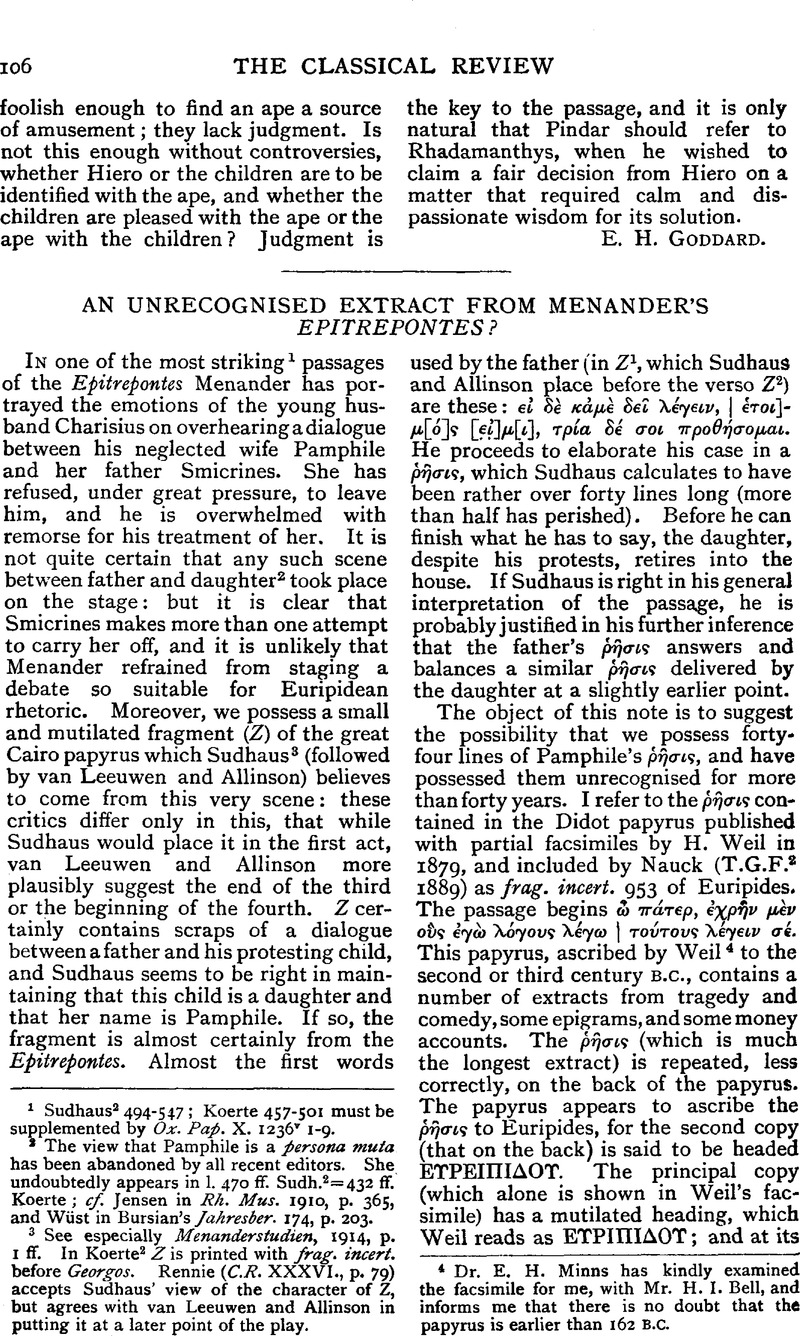Published online by Cambridge University Press: 27 October 2009

page 106 note 1 Sudhaus2 494–547; Koerte 457–501 must be supplemented by Ox. Pap. X. 1236v 1–9.
page 106 note 2 The view that Pamphile is a persona muta has been abandoned by all recent editors. She undoubtedly appears in 1. 470 ff. Sudh.2=432 ff. Koerte; cf. Jensen in Rh. Mus. 1910, p. 365, and Wüst in Bursian's Jahresber. 174, p. 203.
page 106 note 3 See especially Menanderstudien, 1914, p. 1 ff. In Koerte2Z is printed with frag, incert. before Georgos. Rennie (C.R. XXXVI., p. 79) accepts Sudhaus' view of the character of Z, but agrees with van Leeuwen and Allinson in putting it at a later point of the play.
page 106 note 4 Dr. E. H. Minns has kindly examined the facsimile for me, with Mr. H. I. Bell, and informs me that there is no doubt that the papyrus is earlier than 162 B.C.
page 107 note 1 But Tyrrell's suggestion that the fourth foot of 1. 32 is an anapaest is baseless: the third foot is clearly a dactyl.
page 107 note 2 LI. 25, 26 of the ![]() resemble very closely Menander fr. 404 K (from the Plocium) 11. 7, 8—
resemble very closely Menander fr. 404 K (from the Plocium) 11. 7, 8—![]() .
.
page 107 note 3 ![]() 11. 31, 32: but Euripides has similar breaks with οὐδείς: an anapaest in the second foot, 1. 56: ταῦτα προσάγω at the opening of 1. 57: οὕτω συνδοκεῖ at the close of 1. 67.
11. 31, 32: but Euripides has similar breaks with οὐδείς: an anapaest in the second foot, 1. 56: ταῦτα προσάγω at the opening of 1. 57: οὕτω συνδοκεῖ at the close of 1. 67.
page 108 note 1 L. 385, ![]() which Sudh. claims to have read with certainty; but Menander may have scanned
which Sudh. claims to have read with certainty; but Menander may have scanned ![]() : in 1.353, where Sudh. reads ῥόθιον μέγα only ῥοθ is certain. The opening of 1. 360 is corrupt: some restorations needlessly violate tragic metre. For further tragic characteristics of this passage see P. Maass in Rh. M. LXVIII., 1913, p. 361. The form τουτί is used in 1. 357.
: in 1.353, where Sudh. reads ῥόθιον μέγα only ῥοθ is certain. The opening of 1. 360 is corrupt: some restorations needlessly violate tragic metre. For further tragic characteristics of this passage see P. Maass in Rh. M. LXVIII., 1913, p. 361. The form τουτί is used in 1. 357.
page 108 note 2 Sudh.2 631 ff. = Koerte 525 ff.
page 108 note 3 Sudh.2 644 ff. = Koerte 538 ff.
page 108 note 4 Schol. Ambros ad loc. (MSS. ![]() corr. Meineke).
corr. Meineke).
page 109 note 1 So in Demosth. Or. XLI. 4, when Polyeuctus quarrelled with his son-in-law Leocrates, ![]()
page 109 note 2 Ll. 24–26 of the ῥῆσις are quoted by Capps to illustrate this passage of the Epitrepontes.